Davide Zilli
A Bayesian Approach for Prioritising Driving Behaviour Investigations in Telematic Auto Insurance Policies
Apr 22, 2024



Abstract:Automotive insurers increasingly have access to telematic information via black-box recorders installed in the insured vehicle, and wish to identify undesirable behaviour which may signify increased risk or uninsured activities. However, identification of such behaviour with machine learning is non-trivial, and results are far from perfect, requiring human investigation to verify suspected cases. An appropriately formed priority score, generated by automated analysis of GPS data, allows underwriters to make more efficient use of their time, improving detection of the behaviour under investigation. An example of such behaviour is the use of a privately insured vehicle for commercial purposes, such as delivering meals and parcels. We first make use of trip GPS and accelerometer data, augmented by geospatial information, to train an imperfect classifier for delivery driving on a per-trip basis. We make use of a mixture of Beta-Binomial distributions to model the propensity of a policyholder to undertake trips which result in a positive classification as being drawn from either a rare high-scoring or common low-scoring group, and learn the parameters of this model using MCMC. This model provides us with a posterior probability that any policyholder will be a regular generator of automated alerts given any number of trips and alerts. This posterior probability is converted to a priority score, which was used to select the most valuable candidates for manual investigation. Testing over a 1-year period ranked policyholders by likelihood of commercial driving activity on a weekly basis. The top 0.9% have been reviewed at least once by the underwriters at the time of writing, and of those 99.4% have been confirmed as correctly identified, showing the approach has achieved a significant improvement in efficiency of human resource allocation compared to manual searching.
HumBugDB: A Large-scale Acoustic Mosquito Dataset
Oct 14, 2021

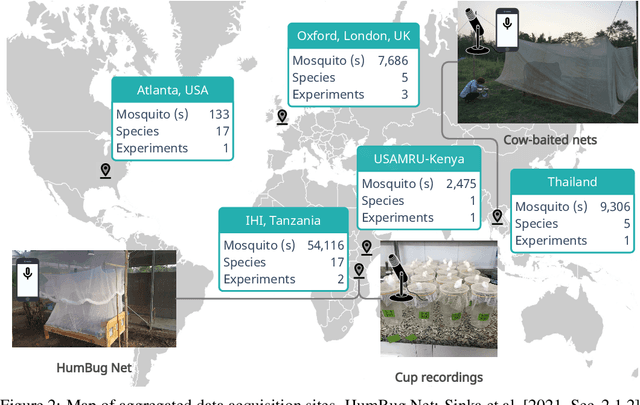
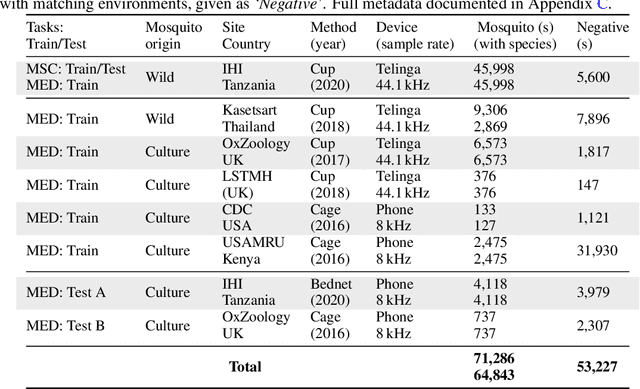
Abstract:This paper presents the first large-scale multi-species dataset of acoustic recordings of mosquitoes tracked continuously in free flight. We present 20 hours of audio recordings that we have expertly labelled and tagged precisely in time. Significantly, 18 hours of recordings contain annotations from 36 different species. Mosquitoes are well-known carriers of diseases such as malaria, dengue and yellow fever. Collecting this dataset is motivated by the need to assist applications which utilise mosquito acoustics to conduct surveys to help predict outbreaks and inform intervention policy. The task of detecting mosquitoes from the sound of their wingbeats is challenging due to the difficulty in collecting recordings from realistic scenarios. To address this, as part of the HumBug project, we conducted global experiments to record mosquitoes ranging from those bred in culture cages to mosquitoes captured in the wild. Consequently, the audio recordings vary in signal-to-noise ratio and contain a broad range of indoor and outdoor background environments from Tanzania, Thailand, Kenya, the USA and the UK. In this paper we describe in detail how we collected, labelled and curated the data. The data is provided from a PostgreSQL database, which contains important metadata such as the capture method, age, feeding status and gender of the mosquitoes. Additionally, we provide code to extract features and train Bayesian convolutional neural networks for two key tasks: the identification of mosquitoes from their corresponding background environments, and the classification of detected mosquitoes into species. Our extensive dataset is both challenging to machine learning researchers focusing on acoustic identification, and critical to entomologists, geo-spatial modellers and other domain experts to understand mosquito behaviour, model their distribution, and manage the threat they pose to humans.
Cost-sensitive detection with variational autoencoders for environmental acoustic sensing
Dec 07, 2017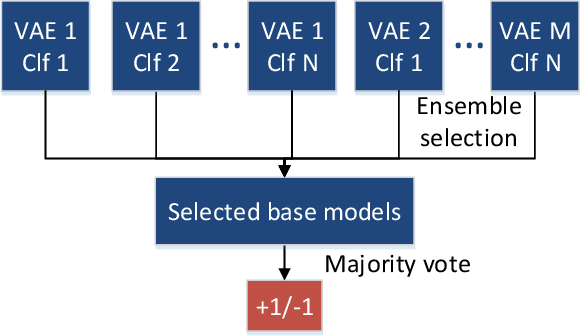
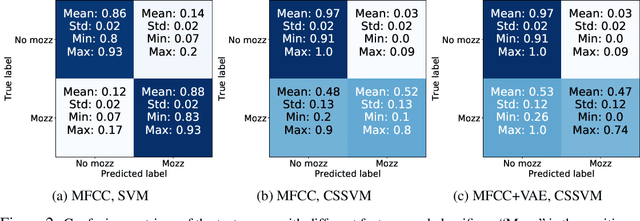
Abstract:Environmental acoustic sensing involves the retrieval and processing of audio signals to better understand our surroundings. While large-scale acoustic data make manual analysis infeasible, they provide a suitable playground for machine learning approaches. Most existing machine learning techniques developed for environmental acoustic sensing do not provide flexible control of the trade-off between the false positive rate and the false negative rate. This paper presents a cost-sensitive classification paradigm, in which the hyper-parameters of classifiers and the structure of variational autoencoders are selected in a principled Neyman-Pearson framework. We examine the performance of the proposed approach using a dataset from the HumBug project which aims to detect the presence of mosquitoes using sound collected by simple embedded devices.
Mosquito detection with low-cost smartphones: data acquisition for malaria research
Dec 06, 2017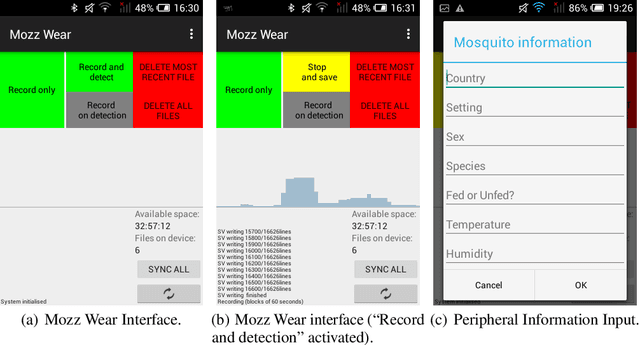

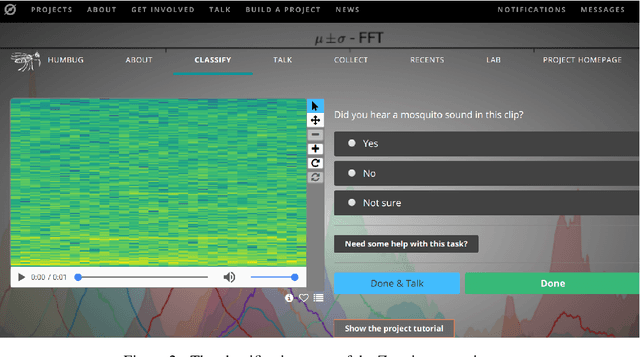
Abstract:Mosquitoes are a major vector for malaria, causing hundreds of thousands of deaths in the developing world each year. Not only is the prevention of mosquito bites of paramount importance to the reduction of malaria transmission cases, but understanding in more forensic detail the interplay between malaria, mosquito vectors, vegetation, standing water and human populations is crucial to the deployment of more effective interventions. Typically the presence and detection of malaria-vectoring mosquitoes is only quantified by hand-operated insect traps or signified by the diagnosis of malaria. If we are to gather timely, large-scale data to improve this situation, we need to automate the process of mosquito detection and classification as much as possible. In this paper, we present a candidate mobile sensing system that acts as both a portable early warning device and an automatic acoustic data acquisition pipeline to help fuel scientific inquiry and policy. The machine learning algorithm that powers the mobile system achieves excellent off-line multi-species detection performance while remaining computationally efficient. Further, we have conducted preliminary live mosquito detection tests using low-cost mobile phones and achieved promising results. The deployment of this system for field usage in Southeast Asia and Africa is planned in the near future. In order to accelerate processing of field recordings and labelling of collected data, we employ a citizen science platform in conjunction with automated methods, the former implemented using the Zooniverse platform, allowing crowdsourcing on a grand scale.
Mosquito Detection with Neural Networks: The Buzz of Deep Learning
May 15, 2017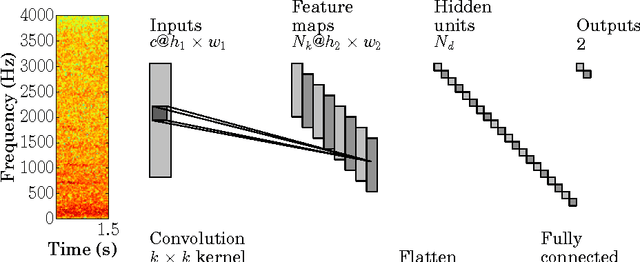

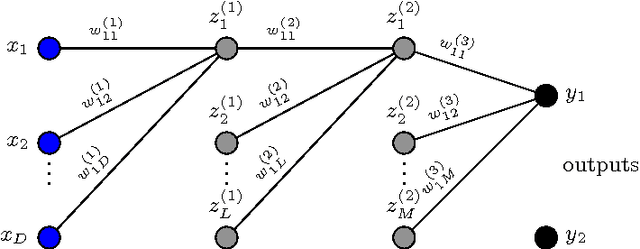
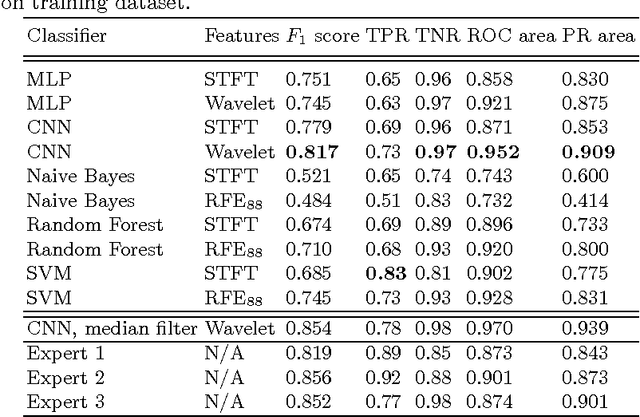
Abstract:Many real-world time-series analysis problems are characterised by scarce data. Solutions typically rely on hand-crafted features extracted from the time or frequency domain allied with classification or regression engines which condition on this (often low-dimensional) feature vector. The huge advances enjoyed by many application domains in recent years have been fuelled by the use of deep learning architectures trained on large data sets. This paper presents an application of deep learning for acoustic event detection in a challenging, data-scarce, real-world problem. Our candidate challenge is to accurately detect the presence of a mosquito from its acoustic signature. We develop convolutional neural networks (CNNs) operating on wavelet transformations of audio recordings. Furthermore, we interrogate the network's predictive power by visualising statistics of network-excitatory samples. These visualisations offer a deep insight into the relative informativeness of components in the detection problem. We include comparisons with conventional classifiers, conditioned on both hand-tuned and generic features, to stress the strength of automatic deep feature learning. Detection is achieved with performance metrics significantly surpassing those of existing algorithmic methods, as well as marginally exceeding those attained by individual human experts.
 Add to Chrome
Add to Chrome Add to Firefox
Add to Firefox Add to Edge
Add to Edge